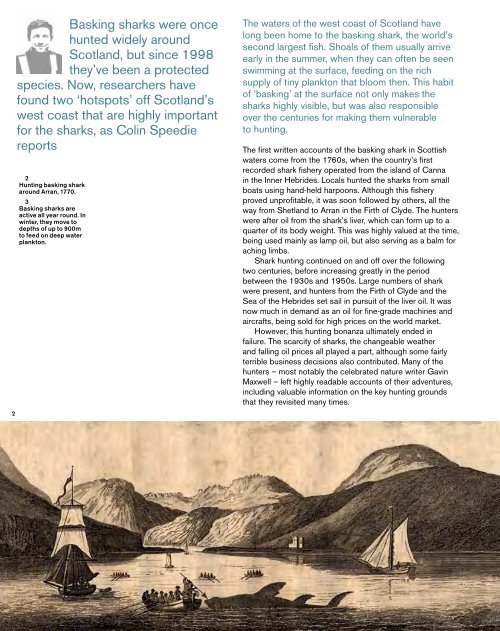Create successful ePaper yourself
Turn your PDF publications into a flip-book with our unique Google optimized e-Paper software.
2<br />
Basking sharks were once<br />
hunted widely around<br />
<strong>Scotland</strong>, but since 1998<br />
they’ve been a protected<br />
species. Now, researchers have<br />
found two ‘hotspots’ <strong>of</strong>f <strong>Scotland</strong>’s<br />
west coast that are highly important<br />
for the sharks, as Colin Speedie<br />
reports<br />
2<br />
Hunting basking shark<br />
around Arran, 1770.<br />
3<br />
Basking sharks are<br />
active all year round. In<br />
winter, they move to<br />
depths <strong>of</strong> up to 900m<br />
to feed on deep water<br />
plankton.<br />
<strong>The</strong> waters <strong>of</strong> the west coast <strong>of</strong> <strong>Scotland</strong> have<br />
long been home to the basking shark, the world’s<br />
second largest fish. Shoals <strong>of</strong> them usually arrive<br />
early in the summer, when they can <strong>of</strong>ten be seen<br />
swimming at the surface, feeding on the rich<br />
supply <strong>of</strong> tiny plankton that bloom then. This habit<br />
<strong>of</strong> ‘basking’ at the surface not only makes the<br />
sharks highly visible, but was also responsible<br />
over the centuries for making them vulnerable<br />
to hunting.<br />
<strong>The</strong> first written accounts <strong>of</strong> the basking shark in Scottish<br />
waters come from the 1760s, when the country’s first<br />
recorded shark fishery operated from the island <strong>of</strong> Canna<br />
in the Inner Hebrides. Locals hunted the sharks from small<br />
boats using hand-held harpoons. Although this fishery<br />
proved unpr<strong>of</strong>itable, it was soon followed by others, all the<br />
way from Shetland to Arran in the Firth <strong>of</strong> Clyde. <strong>The</strong> hunters<br />
were after oil from the shark’s liver, which can form up to a<br />
quarter <strong>of</strong> its body weight. This was highly valued at the time,<br />
being used mainly as lamp oil, but also serving as a balm for<br />
aching limbs.<br />
Shark hunting continued on and <strong>of</strong>f over the following<br />
two centuries, before increasing greatly in the period<br />
between the 1930s and 1950s. Large numbers <strong>of</strong> shark<br />
were present, and hunters from the Firth <strong>of</strong> Clyde and the<br />
Sea <strong>of</strong> the Hebrides set sail in pursuit <strong>of</strong> the liver oil. It was<br />
now much in demand as an oil for fine-grade machines and<br />
aircrafts, being sold for high prices on the world market.<br />
However, this hunting bonanza ultimately ended in<br />
failure. <strong>The</strong> scarcity <strong>of</strong> sharks, the changeable weather<br />
and falling oil prices all played a part, although some fairly<br />
terrible business decisions also contributed. Many <strong>of</strong> the<br />
hunters – most notably the celebrated nature writer Gavin<br />
Maxwell – left highly readable accounts <strong>of</strong> their adventures,<br />
including valuable information on the key hunting grounds<br />
that they revisited many times.<br />
52 <strong>The</strong> <strong>Nature</strong> <strong>of</strong> <strong>Scotland</strong>

















